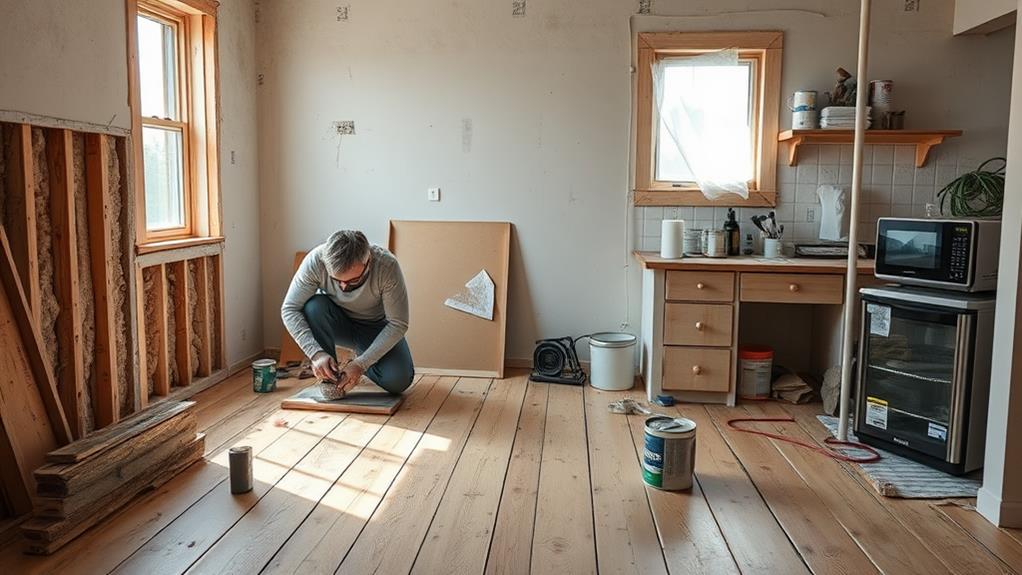Managing a renovation budget while living in the space requires careful planning and strategic decision-making. Start by creating a detailed budget plan, prioritizing essential renovations, and researching costs thoroughly. Set aside 10-20% of your budget for contingencies and unexpected expenses. Consider DIY options for tasks that don't require specialized skills to save money. Optimize your living arrangements by creating functional spaces separate from renovation areas and scheduling work in phases to minimize disruption. Track expenses regularly and be prepared to adjust your plans as needed. By following these tips, you'll be better equipped to navigate the challenges of renovating your occupied home.
Create a Detailed Budget Plan

Before embarking on any renovation project, creating a detailed budget plan is crucial for success. This plan should encompass all aspects of the renovation, including materials, labor, permits, and unexpected contingencies. Begin by researching average costs for similar projects in your area and consulting with contractors for accurate estimates.
Break down the budget into specific categories, such as demolition, electrical work, plumbing, flooring, and finishing touches. Allocate a contingency fund of 10-20% of the total budget to cover unforeseen expenses or changes in the project scope. Prioritize essential renovations and identify areas where costs can be reduced if necessary. Consider the long-term value of each upgrade and its potential return on investment.
When living in the space during renovations, factor in additional costs such as temporary storage, takeout meals, or alternative accommodations if certain areas become uninhabitable. Track expenses meticulously throughout the project, updating the budget regularly to ensure you stay on target. By creating a comprehensive budget plan and adhering to it, you can minimize financial stress and keep your renovation project on track.
Prioritize Essential Renovations
When managing a renovation budget, prioritizing essential renovations is crucial for maximizing value and efficiency. Begin by assessing the structural integrity of your home, focusing on repairs that address safety concerns or prevent further damage. This includes fixing leaky roofs, updating electrical systems, or addressing foundation issues.
Next, consider renovations that improve energy efficiency, such as upgrading insulation, replacing old windows, or installing a more efficient HVAC system. These upgrades can lead to long-term cost savings on utility bills. Prioritize functional improvements in high-traffic areas like kitchens and bathrooms, which can significantly impact daily life and increase property value.
Evaluate the potential return on investment for each renovation. Some projects, like minor kitchen remodels or bathroom updates, typically offer higher returns than others. Consider the local real estate market and which improvements are most valued in your area.
Lastly, factor in your personal needs and lifestyle. If you work from home, creating a functional office space might be a priority. For growing families, adding extra living space or bedrooms could be essential. By carefully prioritizing renovations, you can ensure your budget is allocated to the most impactful and necessary improvements.
Research and Compare Costs

Cost comparison is a crucial step in managing a renovation budget effectively. Begin by researching average costs for materials and labor in your area. Consult multiple sources, including online databases, local contractors, and home improvement stores. Create a detailed spreadsheet to track and compare prices for each aspect of your renovation project.
Obtain at least three quotes from reputable contractors for major work. Be sure to compare not only the total cost but also the breakdown of materials, labor, and any additional fees. Don't hesitate to negotiate prices or ask about potential discounts for bundling services. Consider the quality of materials alongside their cost, as opting for slightly more expensive, durable options may save money in the long run.
Explore alternative materials or finishes that can provide a similar look at a lower cost. For example, luxury vinyl plank flooring can mimic the appearance of hardwood at a fraction of the price. Additionally, investigate the possibility of purchasing gently used or refurbished items, such as appliances or fixtures, to further reduce costs without compromising quality.
Set Aside Contingency Funds
A well-planned renovation budget must include contingency funds to account for unexpected expenses and changes. Industry experts recommend setting aside 10-20% of your total budget for unforeseen costs. This buffer can help cover surprises like hidden structural damage, code compliance issues, or necessary upgrades discovered during the renovation process.
When living in the space during renovations, contingency funds become even more crucial. They can address temporary living arrangements if certain areas become uninhabitable or cover additional cleaning costs to maintain a livable environment. These funds also provide flexibility to make last-minute design adjustments or material upgrades as the project progresses.
To effectively manage contingency funds, establish clear guidelines for their use. Prioritize essential expenses and avoid tapping into this reserve for non-critical changes. Keep detailed records of all contingency spending and regularly reassess the remaining funds. If unexpected costs arise early in the project, consider scaling back on non-essential elements to preserve the contingency buffer. By maintaining a financial cushion throughout the renovation, you can navigate challenges more smoothly and ensure project completion without compromising quality or disrupting your daily life.
DIY Where Possible

Embracing a do-it-yourself approach for certain aspects of your renovation can significantly reduce labor costs and stretch your budget further. Identify tasks that don't require specialized skills or licenses, such as painting, basic demolition, or installing simple fixtures. These can often be completed by homeowners with some research and preparation.
Before taking on DIY projects, assess your abilities honestly and consider the time commitment required. Some tasks may seem simple but can be time-consuming or physically demanding. Factor in the cost of tools and materials needed for DIY work, and compare this to professional quotes to ensure you're truly saving money.
Start with smaller, low-risk projects to build confidence and skills. As you gain experience, you may feel comfortable tackling more complex tasks. However, always prioritize safety and know your limits. Electrical work, plumbing, and structural changes should typically be left to professionals to avoid costly mistakes or safety hazards.
Consider attending workshops or watching online tutorials to learn proper techniques for your DIY projects. This can improve the quality of your work and help you avoid common pitfalls, ultimately saving time and money in the long run.
Optimize Living Arrangements
While renovating your home, carefully planning your living arrangements can significantly impact your budget and overall experience. Consider creating a functional living space within your home that's separate from the renovation area. This may involve setting up a temporary kitchen in another room or designating specific areas for sleeping and relaxation.
If possible, schedule the renovation in phases to minimize disruption and maintain livable conditions. This approach allows you to continue occupying parts of your home while work progresses elsewhere, potentially saving on alternative accommodation costs.
For extensive renovations, weigh the costs of short-term rentals or staying with family against the inconvenience and potential safety risks of living on-site. Factor in the duration of the project, as longer renovations might justify the expense of temporary housing.
Optimize your daily routines to accommodate the renovation. Plan meals that require minimal preparation, create a dedicated workspace if working from home, and establish clear boundaries with contractors to maintain privacy and reduce stress. By thoughtfully managing your living arrangements, you can better control renovation costs and maintain a sense of normalcy throughout the process.
Schedule Renovations Strategically

Strategic scheduling of your renovation projects can lead to significant cost savings and a smoother overall process. Begin by prioritizing the most critical areas that need renovation, such as structural repairs or essential systems like plumbing and electrical. This approach ensures that core improvements are completed first, preventing potential damage to newly renovated spaces later.
Consider seasonal factors when planning your renovations. Some projects, like exterior painting or roofing, are best done in dry weather, while indoor projects can be scheduled during colder months. This strategy can help you take advantage of off-season discounts from contractors and suppliers. Additionally, group related projects together to minimize disruption and potentially reduce labor costs. For instance, combine kitchen and dining room renovations or bathroom and plumbing upgrades.
Stagger your renovations to maintain livable spaces within your home. This approach allows you to spread out costs over time and adjust your budget as needed. It also provides flexibility to reassess priorities and make informed decisions based on the outcomes of earlier renovations. By carefully timing your projects, you can optimize your renovation budget and minimize the impact on your daily life.
Track Expenses Regularly
To effectively manage your renovation budget, consistent expense tracking is crucial. Implement a system to record all expenses related to your renovation project, no matter how small. Use a spreadsheet or budgeting app to categorize costs, including materials, labor, permits, and unexpected expenses. Update this tracker daily or weekly to maintain an accurate picture of your spending.
Compare your actual expenses against your initial budget regularly. This practice helps identify areas where you might be overspending or underspending, allowing you to make timely adjustments. Keep all receipts and invoices organized, either digitally or in a physical file, for easy reference and verification.
Be vigilant about hidden costs that can quickly add up, such as delivery fees, tool rentals, or temporary storage. Include these in your tracking system to prevent budget overruns. If you're working with contractors, request detailed invoices that break down labor and material costs. This transparency enables you to spot any discrepancies or areas where costs might be higher than anticipated. By maintaining meticulous expense tracking, you'll have better control over your renovation budget and be better equipped to make informed decisions throughout the project.
Frequently Asked Questions
How Do I Handle Unexpected Structural Issues Discovered During Renovation?
When unexpected structural issues arise during renovation, immediately consult with a professional engineer or architect. Assess the severity, obtain cost estimates for necessary repairs, and adjust your project timeline and budget accordingly. Prioritize safety and compliance with building codes.
What Permits Are Typically Required for Home Renovations?
Wondering about renovation permits? Typically, you'll need permits for structural changes, electrical work, plumbing modifications, and major additions. Building, mechanical, and zoning permits are common. Always check with your local building department for specific requirements in your area.
How Can I Minimize Dust and Debris While Living in the Space?
To minimize dust and debris while living in a renovation space, use plastic sheeting to seal off work areas, implement daily clean-up routines, utilize air purifiers, and consider temporary relocation during particularly messy phases of the project.
Are There Tax Deductions Available for Home Renovation Expenses?
Generally, home renovation expenses are not tax-deductible for personal residences. However, certain energy-efficient upgrades may qualify for tax credits. Home improvements related to medical needs or home office spaces might also be eligible for deductions. Consult a tax professional for specifics.
How Do I Choose the Right Contractor for My Renovation Project?
Selecting the perfect contractor can be daunting. Start by researching credentials, checking references, and comparing quotes. Schedule interviews to assess communication skills and compatibility. Don't rush; the right choice will ensure a smooth renovation journey.
Conclusion
Effectively managing a renovation budget while living in the space requires meticulous planning, prioritization, and adaptability. By creating a comprehensive budget, focusing on essential upgrades, and researching cost-effective solutions, homeowners can navigate the choppy waters of renovation without capsizing their finances. Strategic scheduling, DIY efforts, and regular expense tracking further contribute to a successful project. With careful management and a contingency fund, the renovation process can be streamlined, minimizing disruptions and maximizing value, ultimately transforming living spaces without breaking the bank.

